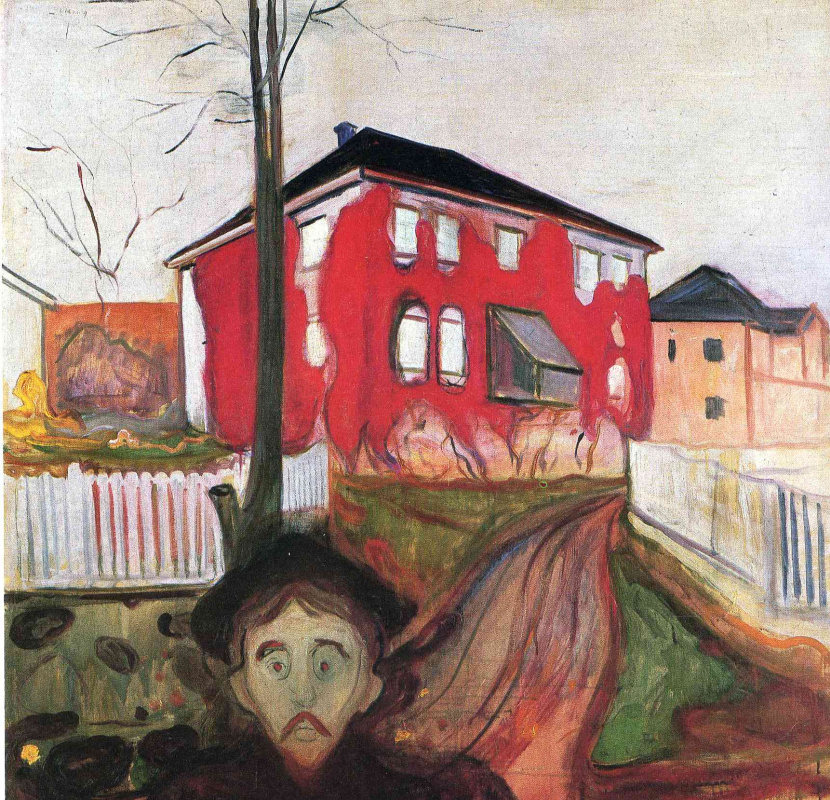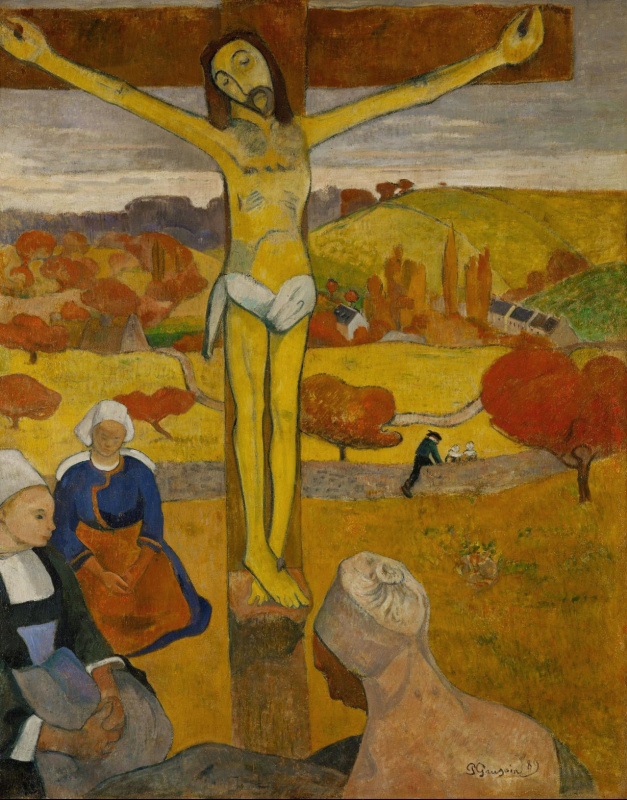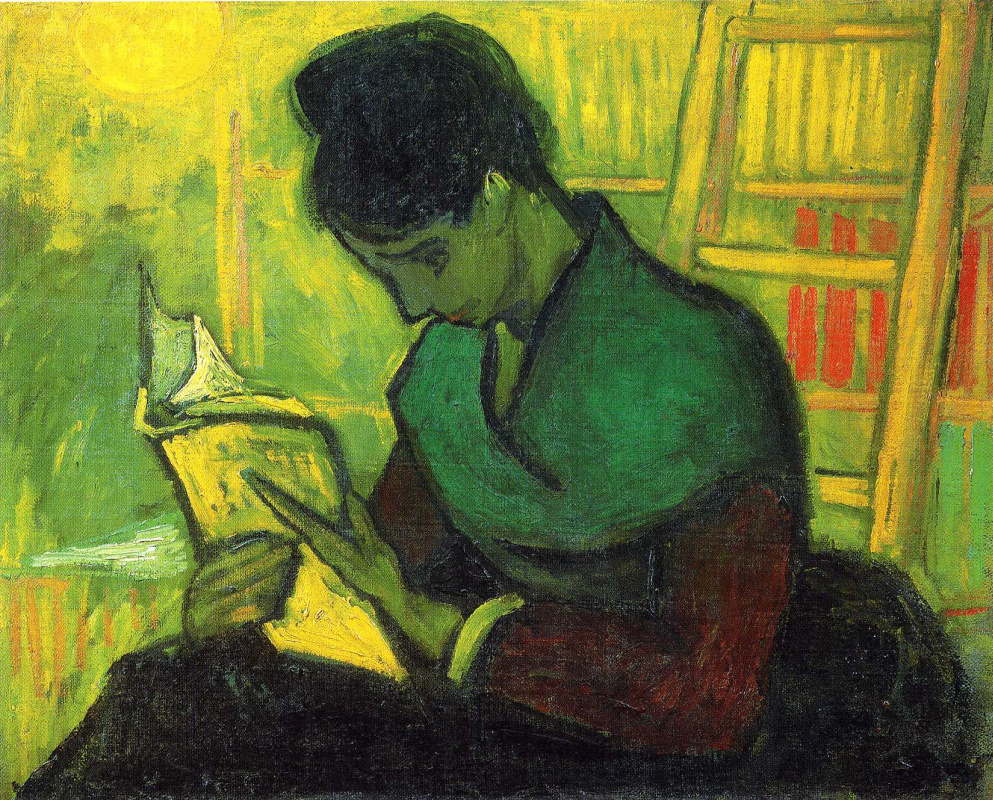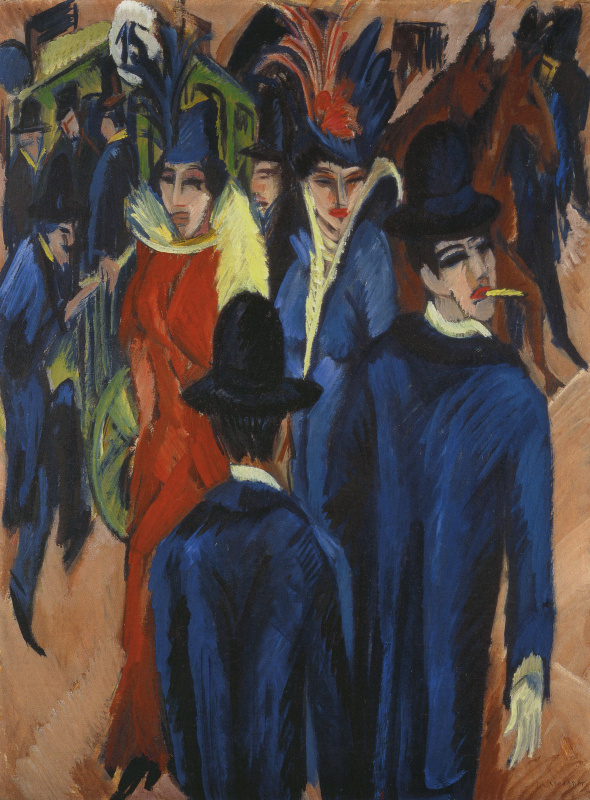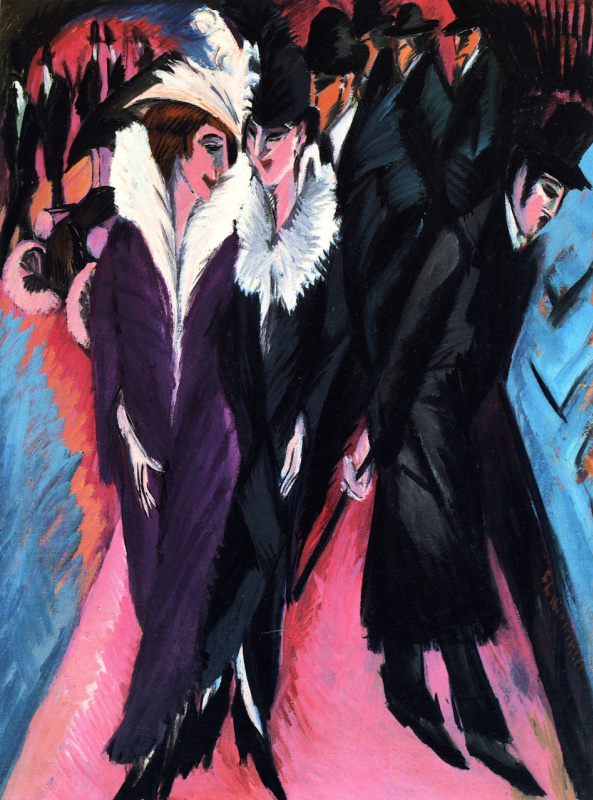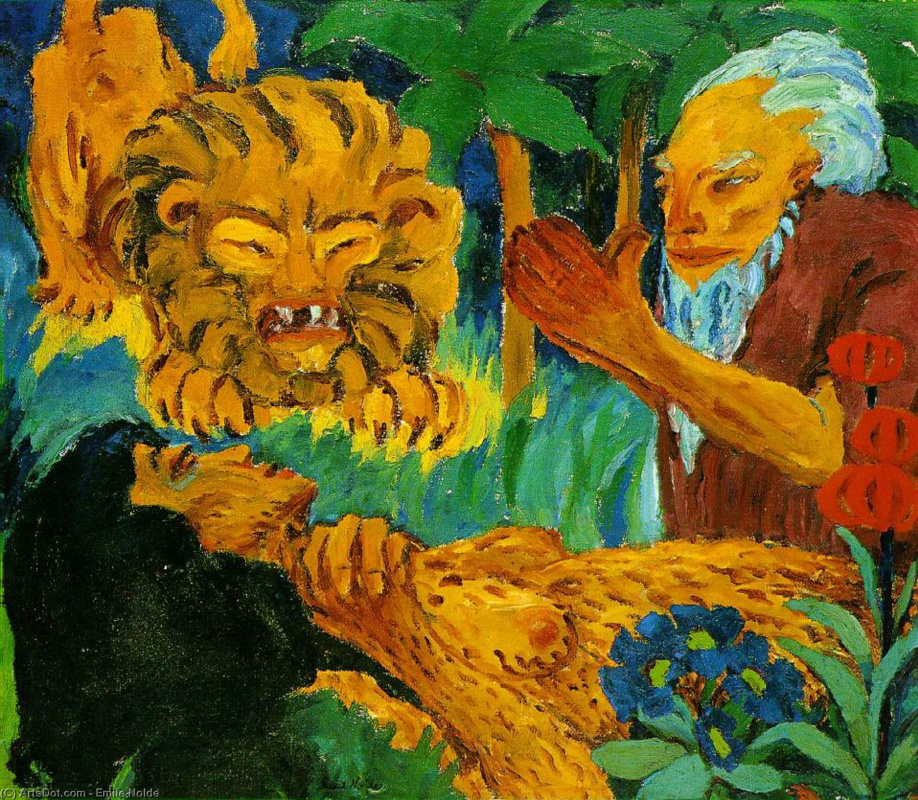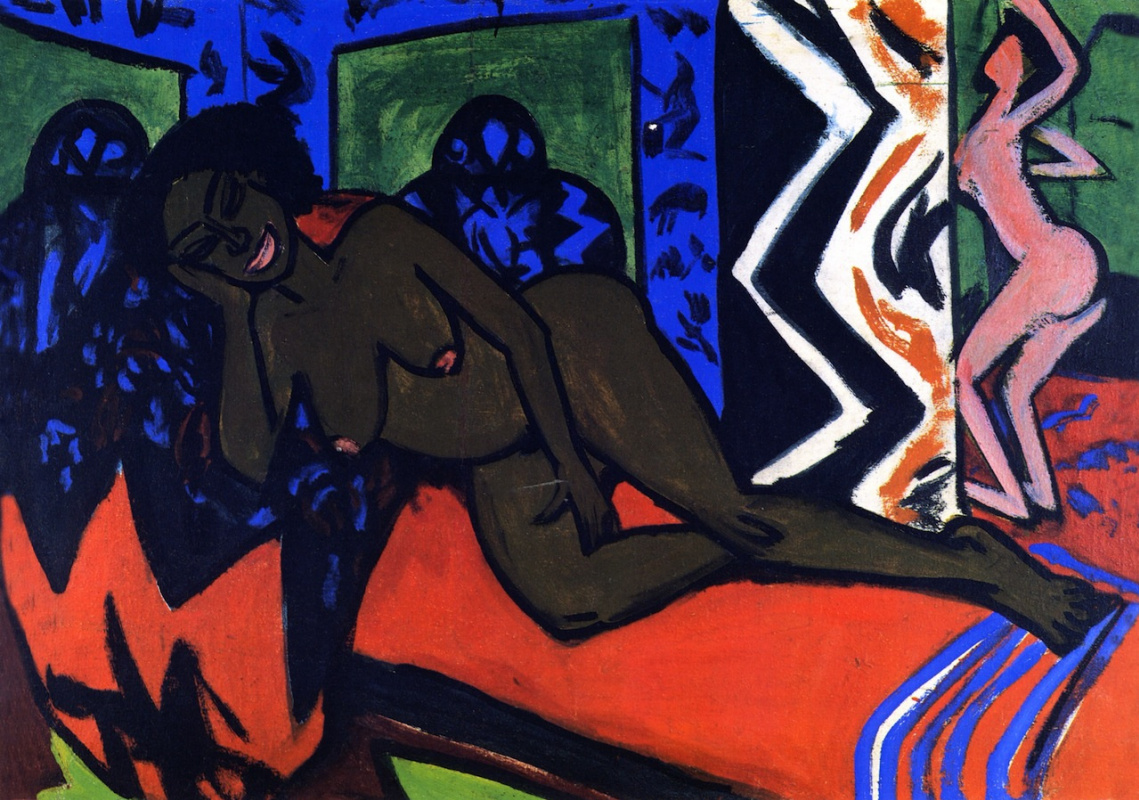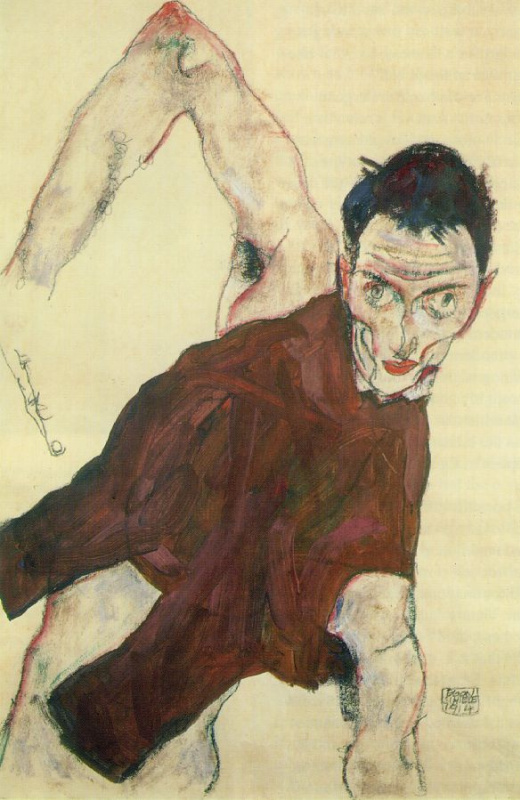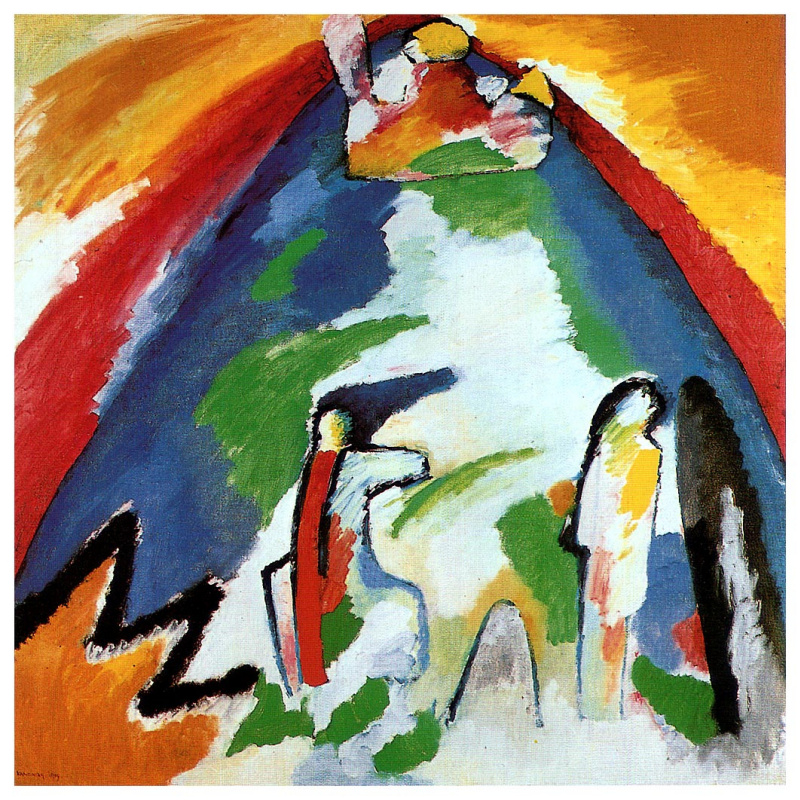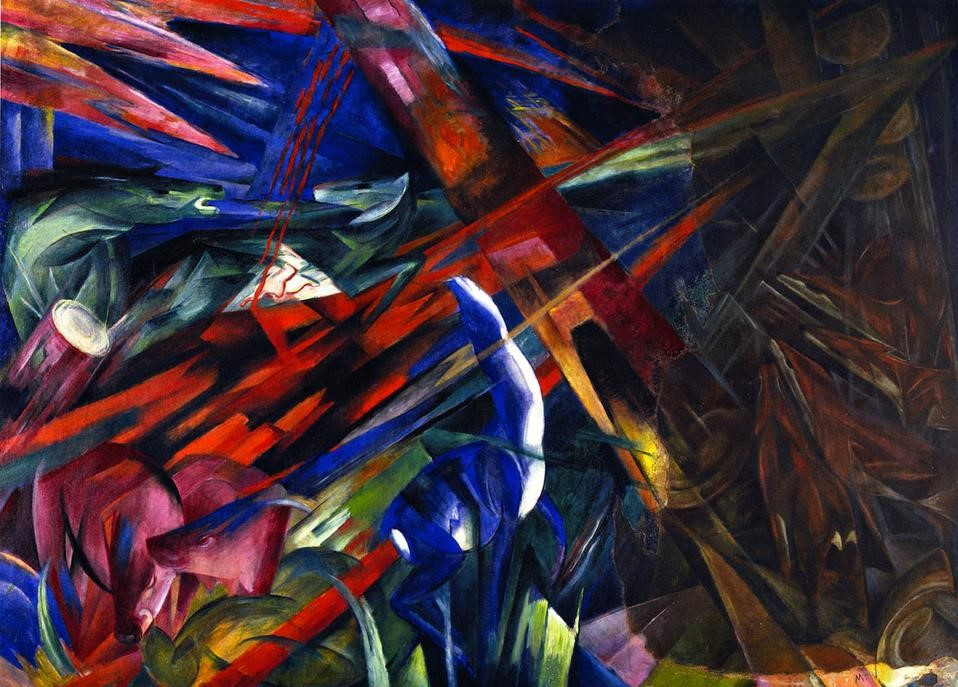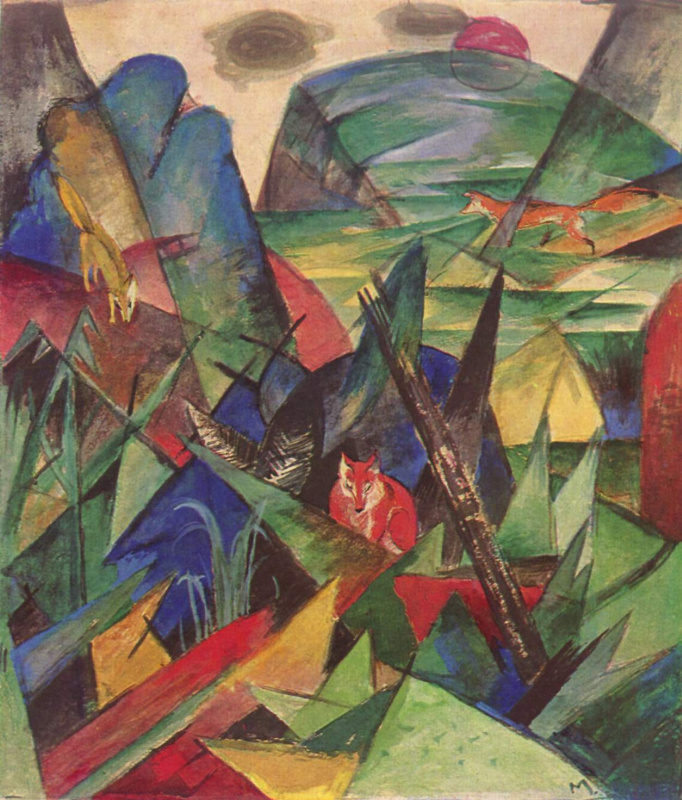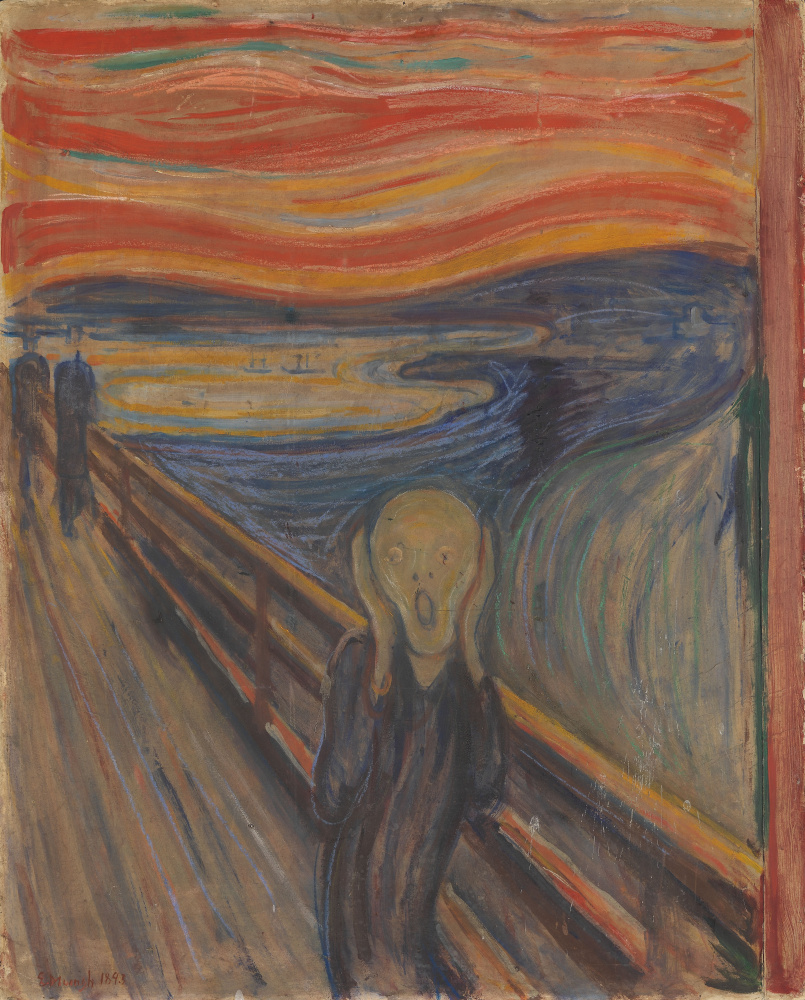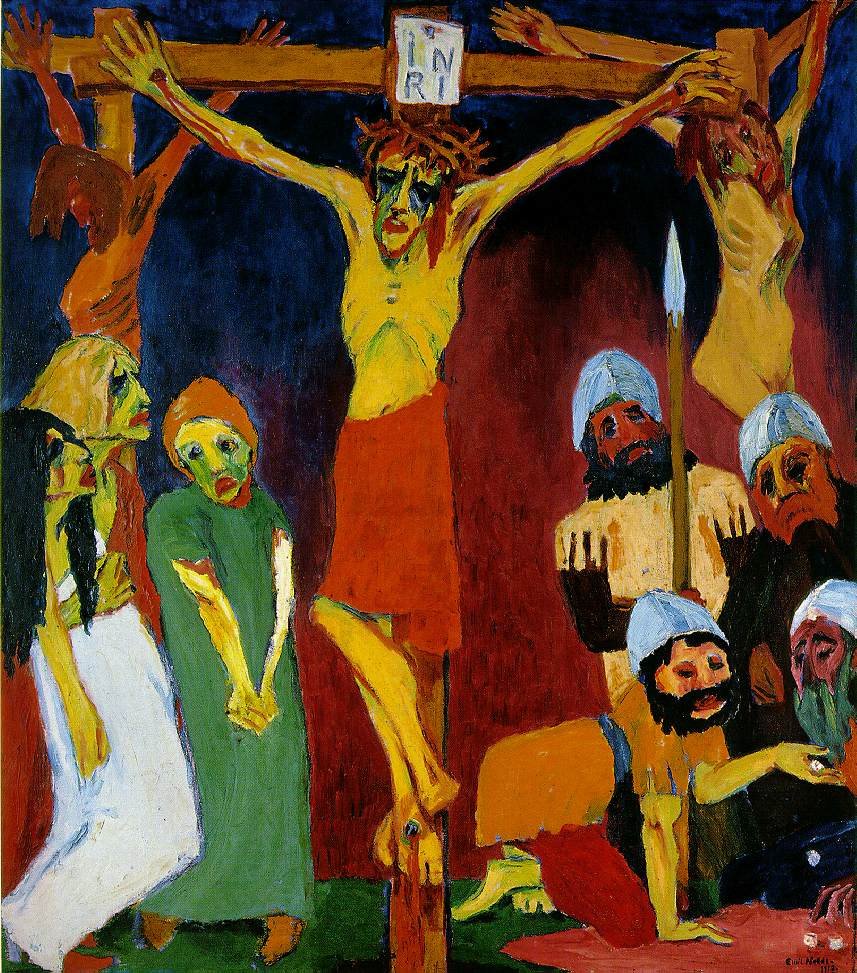You can hardly tell the exact day or year of the birth of Expressionism, which is usual for all powerful art movements. You cannot draw a border on the map and indicate the territory where Expressionism took its start and got stronger. Overall, it’s all roughly known. Except for one rock-solid spatiotemporal benchmark: Northern Europe on the eve of the First World War. Expressionism is an avant-garde art movement, a new tragic worldview, and a whole set of significant motifs, symbols, and myths. Moreover, it is a revolutionary reaction both to the shabby, lifeless traditional academic art, and the light, idyllic southern impressionistic "appearance" of the world.
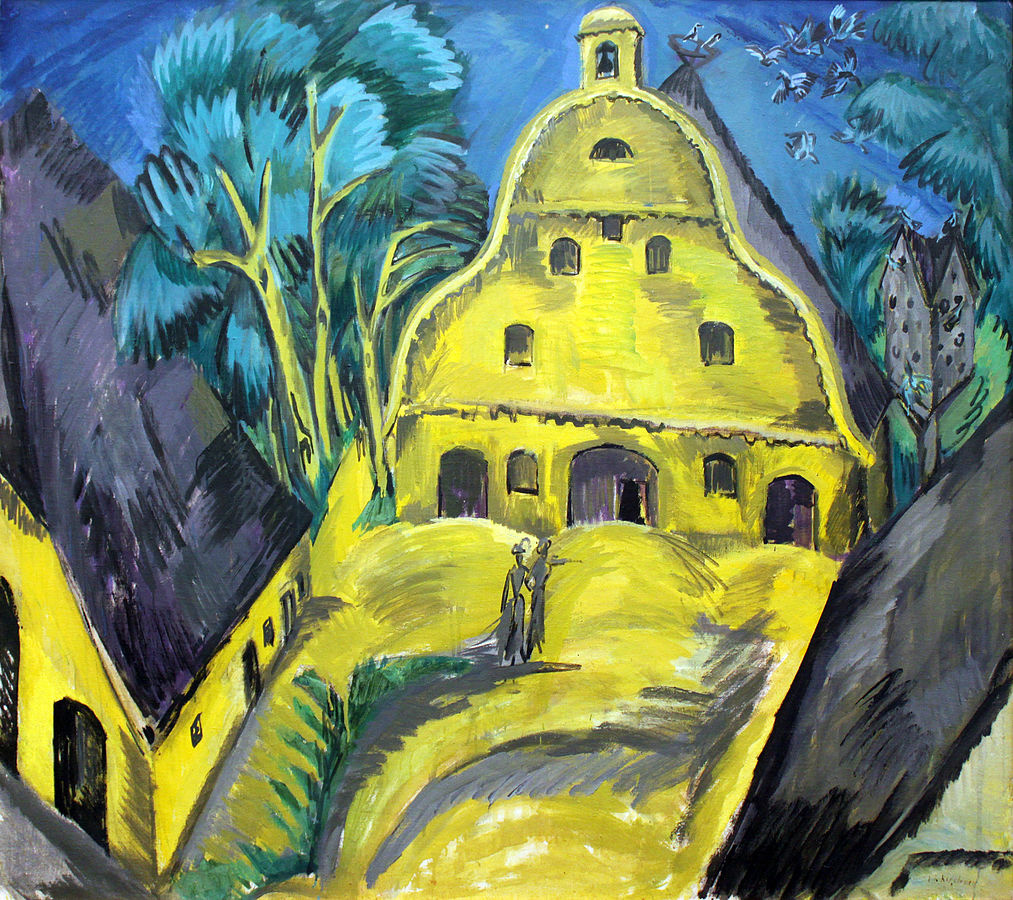
The term "Expressionism", as is often the case, was invented by critics or journalists. There are several versions; all of them are most probably true.
The first version is beautiful. At one of the exhibitions, a collector looking at the picture asked somebody, "Is this Impressionism ?" "No," they said jokingly, "this is Expressionism."
The second version is documented: in 1911, the Der Sturm magazine applied the term "Expressionists" to French Post-Impressionists, as well as Munch, Picasso, Braque and some German artists whose works were represented at the exhibition of the Berlin Secession.
The third version is rather worldview: art historian Wilhelm Worringer was the first to indicate a philosophical and art historical description of the term in his book "Abstraction and Empathy". This was the same scientist who would later tell about the relationship of Expressionism to Gothic and Northern tradition in his manifesto "The Struggle for Art", in cooperation with Wassily Kandinsky and Franz Marc.
The first version is beautiful. At one of the exhibitions, a collector looking at the picture asked somebody, "Is this Impressionism ?" "No," they said jokingly, "this is Expressionism."
The second version is documented: in 1911, the Der Sturm magazine applied the term "Expressionists" to French Post-Impressionists, as well as Munch, Picasso, Braque and some German artists whose works were represented at the exhibition of the Berlin Secession.
The third version is rather worldview: art historian Wilhelm Worringer was the first to indicate a philosophical and art historical description of the term in his book "Abstraction and Empathy". This was the same scientist who would later tell about the relationship of Expressionism to Gothic and Northern tradition in his manifesto "The Struggle for Art", in cooperation with Wassily Kandinsky and Franz Marc.
"Self-portrait with masks"
1899, 80×120 cm
On the eve of Expressionism
Expressionism was not an explosion of an excessive social tension or general fatigue after a solemn impressionistic light show. This movement had its lone prophets, who compressed the basics for it, invented the pictorial language, brought Christ back to the present day, and admitted exotic gods and monsters into it.The French artists Van Gogh and Gauguin are believed to be the precursors of Expressionism, thanks to the exotic barbarism, introduced from the islands, and to Christ, who had come down to earth. Belgian artist James Ensor is not only considered the predecessor of the Expressionists, but also that of the Surrealists: people in his paintings wear faces looking like masks, while the masks on his canvases, on the contrary, look quite alive — primitive fear and irony. The Norwegian painter Edward Munch is even called an Expressionist for the sake of simplicity, as he was the first to create the frightening, greedy, vampirish love, and his landscapes caused an inexplicable sense of constant threat.
Edvard Munch was not an Expressionist painter. At a young age he admired Impressionism, went to France, painted the statue of Rodin, and copied paintings by Gustave Caillebotte. Before the First World War, Munch was 50, he already experienced several nervous breakdowns, the years of desperate fears and inexplicable anxiety, and painted several versions of By The Death Bed and The Scream. His personal North and his personal war had made Munch an Expressionist before this term was coined, and before his young followers in Germany and Austria talked about the presentiment of a global disaster, distorted world and deformed reality.
At the deathbed
1895
Edvard Munch was an artist beyond any styles or movements. However, his artistic world, terrible and hostile one, motivated by his tragic childhood memories and adult fears, appeared to tune in to the sensations and worldview of a whole generation of young artists for dozens of years to come. Prosperous children of reasonable parents, students of the architectural faculty of the Higher Technical School — all of them recognized the language of the saucy pictorial contrasts, flaming skies, distorted faces in Munch’s paintings; the only true language to describe the modern world.
At night
1912, 95×87 cm
The world is doomed
Berlin became the capital of Germany in 1871. Before the First World War, its population increased by 2.5 times, because people came to the capital in search of work, luck, and money. At the beginning of the twentieth century, the city was dramatically growing, while the thirst for renewal became unquenchable and dangerous. There were so many cars that there appeared a need for regulators. Trams and buses carried citizens to either end of the city, and the Potsdamer Platz was the place of the largest hotel in Europe. Berlin shone with the storefronts, advertisements, headlights, lights of the nightclubs and theaters; it was the most illuminated city in Europe, because it had a whole quarter named after the industrial giant Siemens. At the beginning of the century, it was the place where electrical cables were made.In the beginning of the century, Berlin received a biting nickname, the Whore of Babylon. Unlike other European cities, there were no organized brothels in Berlin. Prostitutes were looking for their customers right on the streets and squares, mingling with crowds of passers-by tearing along the streets. However, the work was not that easy: they needed to be visible enough, but not too vulgar. The morality brigades monitored the acts of inappropriate behaviour in the night city, so the streetwalkers were to make them suspect nothing. Thus, the prostitutes and their clients had created a special language of smiles, winks, imperceptible gestures to make it possible to recognize the person needed and to agree on a deal.
Berlin sought to become the most beautiful city in the world, no worse than Paris, the capital of culture, or London, the capital of industrialization. It developed at a frantic pace, accumulating the tension of people, who were not ready for such rapid changes. More and more women were working in factories. More and more disaffected men viewed it as a threat to their families, the offspring and their own ego. More and more workers were desperately losing the feeling of being a master and turned out to be the nameless cogs in a serial production machine. Berliners could choose from dozens of new trendy drinking establishments, but they could not choose their own authorities. Bridges and factories were built, impressive industrial exhibitions were organized, and at the same time, cultures and traditions of the colonies were shamelessly grinded.
In 1911, a group of German artists, who created the first Expressionist association "The Bridge", came from Dresden to Berlin. It was the Berlin described above.
In 1911, a group of German artists, who created the first Expressionist association "The Bridge", came from Dresden to Berlin. It was the Berlin described above.
Bathers among the reeds
1909, 71×81 cm
All the Germans did this
1905 is officially considered to be the year when Expressionism was born. It was the year of the foundation of "The Bridge" association. Four architect students from Dresden, Ernst Ludwig Kirchner, Fritz Bleyl, Karl Schmidt-Rottluf, and Erich Heckel, decided to change the German art. Later members were Emil Nolde, Max Pechstein and other artists. "The Bridge", just like Expressionism itself, was synonymous with the new art for some time. The group’s programme was designed as an engraving; it was more about the revolution, rather than the stylistic features: "We call all young people together, and as young people, who carry the future in us, we want to wrest freedom for our actions and our lives from the older, comfortably established forces. We are everyone who expresses the sense, which compels us to create, directly and sincerely."Every avant-garde
movement opposing itself to traditional painting, found its own path out of Academism. Impressionists dropped into acute modernity and instantaneousness. Expressionists did not particularly like modernity, as well as the impressionistic imitation of reality; they inclined to archaism, exotics and mysticism. They considered the visible world to be visible to everyone, which made it senseless to depict it. It is the emotional state of the artist that only matters. Important is his ability to demonstrate this state to viewers by means of shapes, colours, and brushstrokes.
They gladly took vertically elongated shapes from the Gothic art and followed the ancient iconography in the depiction of faces and figures. They related to the grotesque visions of Bosch and Goya, they were fond of mystical expectations and the cult of feelings inherent to Romanticizm, they loved Baroque
for its gloomy pompousness and tense lines. Expressionists revived engraving
, cut wood in a deliberately rough fashion, so that the jagging and asperity remained well visible. Outside the civilized Europe, in colonies, in Africa, they admired primitive but surprisingly expressive shapes of the masks, ritual sculptures, and color simplicity of the engravings.

The first exhibition of "The Bridge" association was held in the exhibition hall of the electric lamp factory (in the photograph above, source: tate.org.uk).
The poster for the exhibition was designed by Fritz Bleyl (reproduction on the left), but German police banned it for obscenity and purposefully destroyed it.
During the Dresden period, the participants of "The Bridge" spend the summers at the Moritzburg lakes in order to hide away from the horror and loneliness of the modern hellish world in the thick of bohemian outdoor parties, relaxed and often nude
. They paint naked women, rather barbarians or wild animals than civilized women. They paint each other and have no illusions: it is the wild, uncontrollable energy that bursts out of a person, revealing innocence and natural grace accompanied by animality, hunger, immorality, and militancy.
After the participants of "The Bridge" had moved to the loud and shiny Berlin, each of them gradually left the previous subjects and hopes to find salvation in the wild. During the remaining three years before the war, they created their most important and emotionally powerful works. However, they worked separately, each on his own. It has appeared that the artistic challenge, initially postulated by the Expressionists, "to paint the artist’s emotions, rather than the external world", "to seek one’s own soul" among others, led to creative solitude and total dissimilarity of everyone. Expressionism did not imply commonality. These Austrian artists, who were later ranked as Expressionists, had always been mavericks.
After the participants of "The Bridge" had moved to the loud and shiny Berlin, each of them gradually left the previous subjects and hopes to find salvation in the wild. During the remaining three years before the war, they created their most important and emotionally powerful works. However, they worked separately, each on his own. It has appeared that the artistic challenge, initially postulated by the Expressionists, "to paint the artist’s emotions, rather than the external world", "to seek one’s own soul" among others, led to creative solitude and total dissimilarity of everyone. Expressionism did not imply commonality. These Austrian artists, who were later ranked as Expressionists, had always been mavericks.
A knight errant (Self-portrait)
1915, 180×89.5 cm
Austrian mavericks
Oskar Kokoschka and Egon Schiele took part in a general wave against Academicism. The majority of Austrian artists (including Gustav Klimt, Schiele’s teacher) painted decorative Art Nouveau panels planning to change the world of art through intruding into the parlours and bedrooms of the average men with their new artistic ideals; whereas Schiele and Kokoschka were not welcome in the respectable apartments.Art Nouveau is always pretty to look at for its eroticism and mysticism of patterns, wide open eyes, golden hair, and the sense of mystery. Eroticism and mysticism of Expressionism are frightening, abysmal, exasperating and exposing: inhumanly twisted hands and feet, the world disassembled into the simplest pieces, colours saturated to the virulence or dirtiness, the feeling of impending doom.
Egon Schiele painted provocative nude
, no longer exposing the body, but the soul of the model. Kokoschka tended to grotesque, close to undecided figures at passional attitude. By the way, Kokoschka was a recognized Expressionist playwright, and his plays caused just as much outrage and pious complaints as his paintings or his rag doll, which accompanied him at the opera and at social events. Generally, the Expressionist painters were good in combining different artistic activities: theatre, literature, music, painting, and sculpture. Expressionists theorized their art, and their theory was very convincing, especially when the Russian artists got into the stage.
Mountain
1909, 109×109 cm
Russian Expressionism in Munich
At first glance, the artistic search of "The Blue Rider" association was somewhere beyond the expressionistic circle of themes and moods. Their involvement in the movement is often argued, since their artworks comprised neither the tense expectation of a disaster, nor the urban loneliness, nor mystical visions. Nevertheless, the original program task of the multinational "The Blue Rider" association from Munich was the same: opposition to the extremely corrupt world, hell-bent on material gain. They sought to compensate for the world’s acquisitiveness with a certain spiritual basis, to get to it and to demonstrate it to the humanity, which still had a chance to survive. According to the theory by Wassily Kandinsky and Franz Marc, a work of art did not need any thematic boosters, since the spiritual and emotional energy was already conveyed in colour and shape. The Expressionism of "The Blue Rider" was surely a stone’s throw away from the abstraction; it would be so.However, in 1911, "The Blue Rider" attracted Russian artists Marianne von Werefkin, Alexej von Jawlensky, Wassily Kandinsky, German artists Franz Marc, August Macke, Paul Klee and still looked for the way out of the traditional art and the rough reality.
For example, the artistic world of Franz Marc is not animalistic in the classical sense of the term. This is philosophical animalism. The same reason, which led "The Bridge" artists to archaism and mysticism, lead him into the animal world, it caused him to look at the surrounding reality through the eyes of the animals. On the one hand, such view gave him new artistic forms, revelations, and on the other hand, he tried to consider the "dream", the "inner truth" under the filth and tinsel of the external shell.
The spirituality of art and the synthesis of arts of "The Blue Rider" participants were described in the eponymous almanac. However, only one issue had been published before the group disbanded. Europe experienced the disaster, which was anticipated and predicted by the Expressionists.
P.S. That inevitable storm, which the Expressionist painters were waiting for, burst out into war, epidemics and poverty, and each of them found himself in the epicenter of the storm. August Macke and Franz Marc died very young in the First World War. Egon Schiele and his pregnant wife died of the Spanish flu at the age of 28. Oskar Kokoschka returned from the war with several wounds and memory loss, and Ludwig Kirchner got a severe mental disorder. Wassily Kandinsky had to return to Russia. Moreover, every Expressionist who managed to live to the second German disaster (the advent of National Socialists rule) saw their paintings at the exhibition named "Degenerate Art".
P.S. That inevitable storm, which the Expressionist painters were waiting for, burst out into war, epidemics and poverty, and each of them found himself in the epicenter of the storm. August Macke and Franz Marc died very young in the First World War. Egon Schiele and his pregnant wife died of the Spanish flu at the age of 28. Oskar Kokoschka returned from the war with several wounds and memory loss, and Ludwig Kirchner got a severe mental disorder. Wassily Kandinsky had to return to Russia. Moreover, every Expressionist who managed to live to the second German disaster (the advent of National Socialists rule) saw their paintings at the exhibition named "Degenerate Art".
Expressionism: summary
Artists with a connection to Expressionism
Edvard Munch, James Ensor, Emil Nolde, Ernst Ludwig Kirchner, Oskar Kokoschka, Egon Schiele, Marianne von Werefkin, Alexej von Jawlensky, Wassily Kandinsky, Franz Marc, August Macke, Gabriele Münter, Max Pechstein, Otto Dix, Erich Heckel, Karl Schmidt-Rottluf, Fritz Bleyl, Lovis Corinth.Reference paintings
Scream
1893, 91×73.5 cm
If we would like to name a possible benchmark of the Expressionist movement beginning, then we absolutely surely should refer to "The Scream" by Edvard Munch. We can feel the primeval, instinctive fear, a mysterious premonition of something inevitable, the nature as an element, the nature that no longer brings peace and rest.
Family
1918, 152×162 cm
Schiele painted "The Family" shortly before his death. This is a self-portrait with his wife Edith and their unborn child. A strange and terrible family portrait: doomed sadness, humility, presentiment and acceptance of the approaching fate. Here, Schiele transforms the nudity of models, which used to be flaunting and extravagant, into the unprotected nakedness.
Self-portrait in soldier's uniform
1915, 69.2×61 cm
Kirchner went off to war as a volunteer and returned a year later. He was not wounded and did not lose his arm in the war. A bloody stump resembling a ham cut in a butcher shop is not a portrait detail on the first Kirchner's post-war self-portrait, but a symbol of impotence. An armless artist… it is not only about physiology (Kirchner's arms were paralyzed after a nervous breakdown), it is also about the inability to speak out.
Bride of the wind
1914, 220×181 cm
In the Expressionist value system, love does not bring happiness, just short illusory hopes instead. The lovers in "The Bride of the Wind" painting by Oskar Kokoschka do not fight against the storm, they do not defeat it with the power of love, but but they freeze in an embrace in the midst of an inevitable environment, an impending chaos.
The Crucifixion of Christ
1912, 220×193 cm
The Expressionists referred to Christian motifs just in order to talk about suffering and pain at top volume, as loud as possible, to approach the archaic, medieval experience of the universe, and, finally, in order to use primitive drawing and primitive painting. "Crucifixion" by Emil Nolde is a part of "The Life of Christ" polyptych. It consists of nine parts and resembles an altarpiece from a medieval village church.
You're an expert, if:
— you can distinguish, for example, the wild, sunny, and emotional local Fauvist yellow color from the electric, acrid, painful Expressionist yellow colour;— you can confidently point the big, bustling, developing city by Impressionist Gustave Caillebotte (1, 2, 3), and the big, bustling, developing city by Expressionist Ernst Ludwig Kirchner (1, 2, 3);
— you have got a serious doubt whether the artists of "The Blue Rider" are depressing and unquiet enough to be called Expressionists.
You're a layman, if:
— you search (and find) the plans of real cities, natural colours and life-like portraits in the paintings by Expressionists;— you treat Expressionism according to a value system like "moral or immoral", "beautiful or ugly", "similar or unlike";
— you feel uncomfortable and scared facing the pictures by Expressionist artists, and you do not like this. Don’t worry, that’s just the way it is! It turns out that you can be a great connoisseur or, conversely, do not have much knowledge of painting, but still achieve the main goal: Expressionists just wanted you to feel uncomfortable and scared.
Main illustration: Ernst Ludwig Kirchner. Gut Staberhof auf Fehmarn. 1913
Author: Anna Sidelnikova
Author: Anna Sidelnikova







